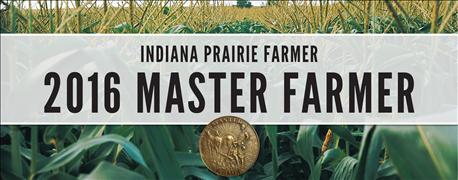
Brad Kohlhagen nominated John and Nan Nidlinger as Master Farmers. He included this line in the description of their cropping program. “Nidlinger Farms Inc. has developed an in-depth database used to analyze their [soil] fertility programs.” If he had ended the sentence at "Nidlinger Farms Inc. has developed an in-depth database," he would have accurately described their entire operation.

Kohlhagen, Purdue Extension ag educator in Adams County, quickly realized that collecting data, analyzing it and making sound decisions based on that data are what John and Nan Nidlinger and their family farming operation are all about. In this case, the statement referred to soil fertility. They incorporated soil testing on 1-acre grids about 20 years ago. Currently all fields are gridded and tested on a two-year rotation. Nobody has to explain the power of big data to this farm family — they’ve been harnessing that power for quite some time.
Maximize each acre
The decision-making team at the farm incudes John, Nan, Duane A. Kiess (Nan’s brother), and John and Nan’s son J.D. Add in one full-time employee, Elliott Gehres, and that's also the work crew that operates the farm.
Perhaps their farm hasn’t grown the fastest of any farm in the state, but it has grown when it made sense to grow, and when financial numbers said they were moving in the right direction, John notes. When it’s time to make financial decisions, according to their lender, Ted Little, they bring the same penchant for details and data that has guided their soil fertility program to the financial world.

BUILD A FAMILY FARM: John and Nan Nidlinger are at the heart of a well-managed family farm operation.
One of their goals on the farm is maximizing the potential from each acre they have, John notes. “We want to reach the maximum economic potential of each acre, but we know we also have to be mindful of the environment,” he says. That includes being very aware of any nutrients that might leach through the tile system. All of their land lies in the Maumee River Watershed, which feeds Lake Erie.
One way they maximize potential without risking excessive runoff or loss of nutrients is by variable-rate fertilizer applications, John notes. They also apply lime and nitrogen using variable rates. They began spreading gypsum in 2014, and also spread it according to variable-rate technology.
Build soil health
Conservation is a big part of what they do, John says. Most of their soybeans are no-tilled. Corn is typically planted through a minimum-tillage system. Their method of choice is to run a vertical-tillage tool across the field that will go to corn.
“We started experimenting with cover crops three years ago,” John observes. “We planted 450 acres to cover crops last fall. We’re anxious to see how that turns out and if it proves to be an economic benefit.”
The farm also includes buffer strips along rivers and creeks to catch sediment carrying fertilizer or chemical particles before they reach the waterway. Grass waterways are maintained where needed.
"We’re also spreading chicken litter, and we think that is the next phase in enhancing soil health and productivity,” John adds.

About the Author(s)
You May Also Like




